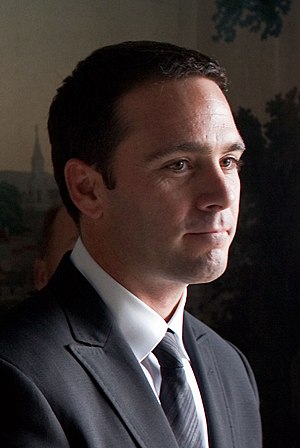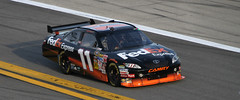 Image via Wikipedia
Image via WikipediaJimmie Johnson took a big step towards his fifth straight Sprint Cup championship this weekend at Dover. Johnson won the pole, led five times for a race-high 191 (of 400) laps and beat Jeff Burton to the finish line by 2.637 seconds.
It was Johnson's sixth career win at Dover, most among active drivers, and his third victory in the last four races at the track. It was Johnson's sixth win of the season and the 53rd of his career. Johnson has now won 19 of the 62 Chase races he has been in.
Johnson passed Kyle Busch for the lead on Lap 337 and held it until a green flag pit stop on Lap 363. After the field cycled through stops, Johnson was back in the lead again and pulled away for the win.
Five of the top 6 finishers were Chase drivers. Kurt Busch overcame a speeding penalty to finish fourth, followed by Carl Edwards and Kyle Busch. Joey Logano finished third to break up the streak. (Race results)
A. J. Allmendinger seemed to be the only driver who could compete with Johnson. He started second and led three times for a career-high 146 laps, but a flat tire put him two laps down. He rallied to a tenth-place finish.
How quickly the tide can turn in NASCAR. Last week at Loudon, Tony Stewart and Clint Bowyer were running 1-2 in the closing laps and looked like strong Chase contenders. Stewart ran out of gas just before taking the white flag and fell to 24th. Bowyer won, but was penalized 150 points when his car failed inspection. At Dover, the misfortunes continued. Both drivers were caught speeding on pit road and couldn't make up their laps. Stewart finished 21st; Bowyer 25th. Now, both drivers are virtually out of the title hunt.
Matt Kenseth got on the brakes too hard trying to get on pit road and blew a tire. He finished 18th. After his second mediocre finish in two Chase races, his title hopes are just about done too. His Roush teammate Greg Biffle finished just behind him in 19th. He was on pit road when a caution came out and lost a lap as a result.
Jeff Gordon had a good run, but lost a lot of time on the final pit stop when a tire changer dropped a lug nut. His car was too loose at the end, and he fell back to finish eleventh. Kevin Harvick also had handling problems at the end and finished 15th.
Denny Hamlin was quite satisfied with a ninth-place finish at one of his worst tracks. That allowed him to hang on to the series lead in the points standings. Johnson moved up four spots to second, 35 points back. Kyle Busch remains in third, 45 points back. Kurt Busch (-59) climbed one spot to fourth. Harvick (-65) dropped three spots to fifth. The top eight -- including Edwards, Burton and Gordon -- are within 83 points of Hamlin.
Hamlin had an eventful few days at Dover. He made quite a few disparaging comments about Richard Childress Racing to the media Friday regarding Clint Bowyer's penalty and the excuses offered up. Harvick took exception and purposefully ran into Hamlin during a practice session Saturday. Both drivers took their cars to the garage to bang out the sheet metal. Since they were 1-2 in points at the time, they had side-by-side stalls in the garage and took the opportunity to air out their differences in a little shouting match. JGR president J. D. Gibbs later told Hamlin something along the lines of "The next time you have a thought, keep it to yourself."
Meanwhile, RCR's appeal of the penalties is set for Wednesday. The numbers are not on their side. There have been 132 appeals since 1999. 88 were upheld, and only 42 were reduced or overturned. In two cases, the penalties were increased. No penalties have been overturned in six appeals this season. If RCR loses the appeal they can make one final appeal to the NASCAR chief appellate officer, John Middlebrook.

























